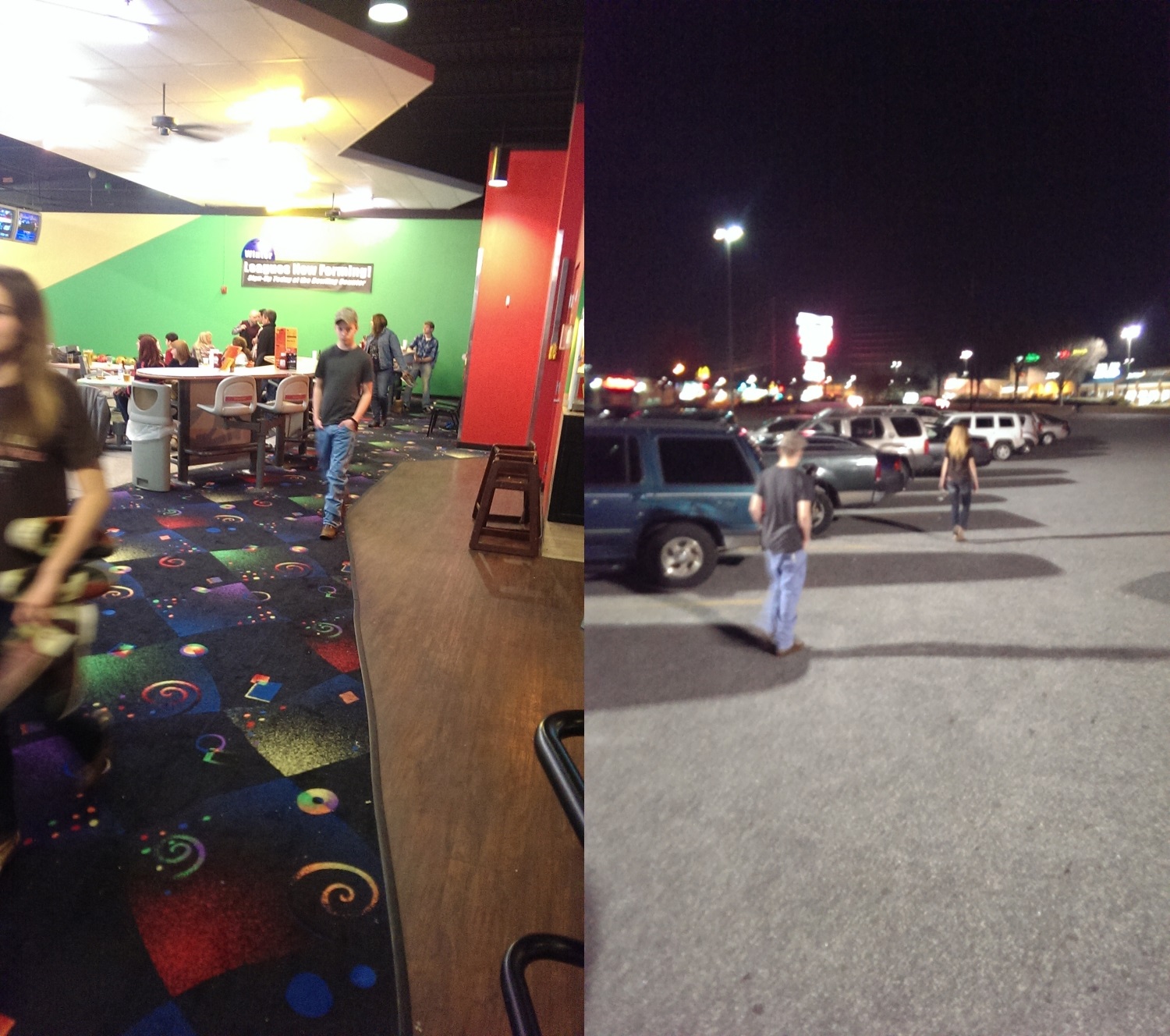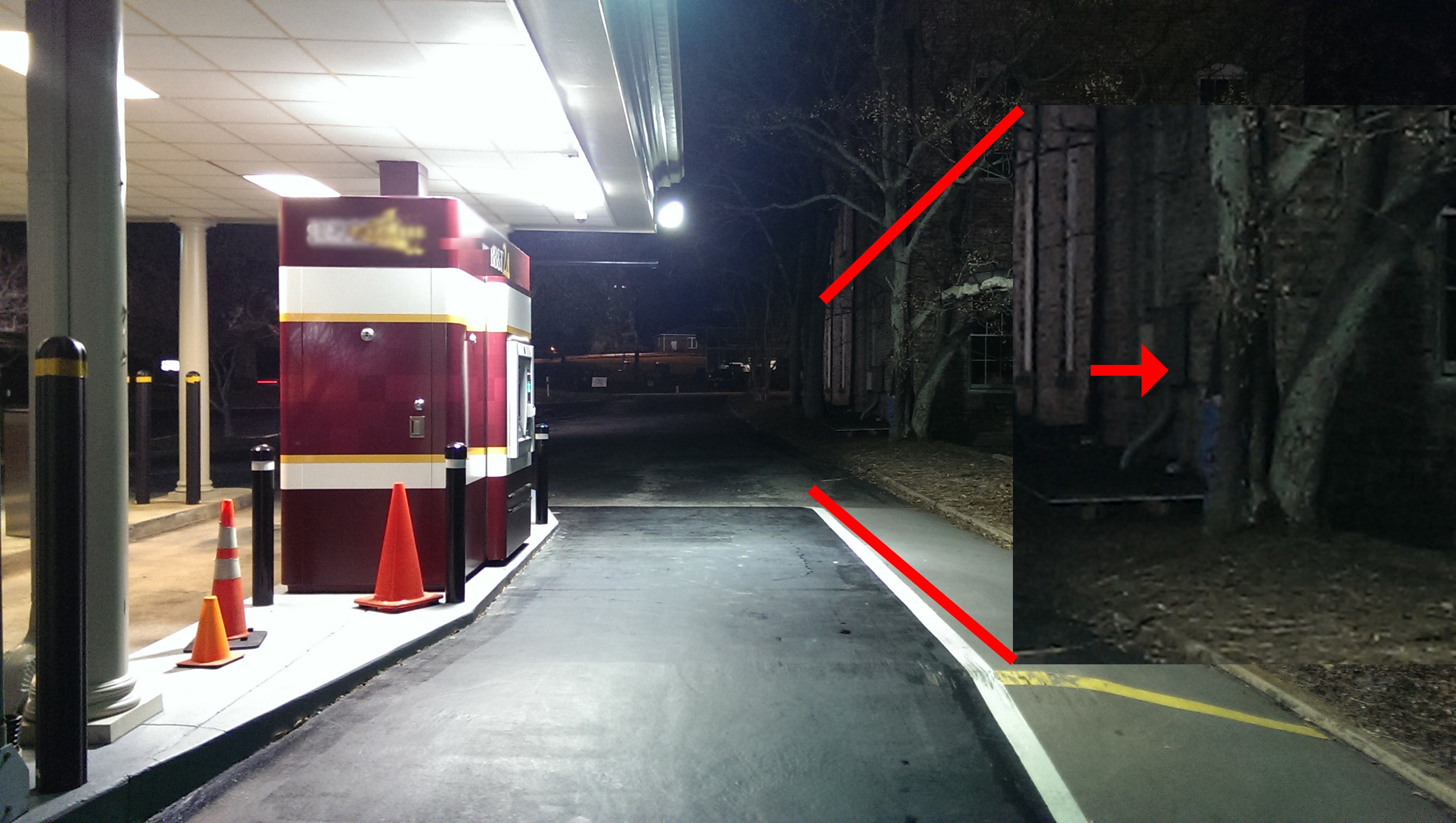On 23 September 2013, a 30-year-old man named Nikhom Thephakaysone was riding on a crowded commuter train in San Francisco. Surveillance video recorded the man drawing a large-frame pistol from his waistband or jacket pocket several times. He pointed the weapon across the aisle of the train directly at the man he would later shoot after exiting that train. At one point he even wiped his nose with his weapon hand while holding the pistol. Dozens of people were in that train car, many in close proximity to the shooter. No one saw him with the gun and as a result, a random innocent person is dead.

The young lady on the left might notice the anomaly in this picture if she were paying attention. Most people are looking down the bowling alley’s lanes. The young man in the baseball hat is looking intently at her. When taken in the context of the environment, he would warrant some special attention. Photo: author
Whatever metaphor you wish to use, those who are not aware of their surroundings cannot take an active part in their own survival. The only reason they have not fallen prey to some vicious sociopath is because he has not chosen them … yet.
Awareness Formula
To be aware of your surroundings, not only do you have to look around you with some positive degree of regularity, but you also have to actually see what is around you and learn to recognize behavior that could represent a potential threat. To help accomplish this, there is a very simple formula to commit to memory.
Baseline + Anomaly = Decision.
Establishing a baseline and then detecting an anomaly are things most of us began doing in preschool with games like the one made popular by the Sesame Street song:
“One of these things is not like the others,
One of these things just doesn’t belong.
Can you tell which thing is not like the others
By the time I finish my song?”

Seeing these two surveillance photos from the bowling alley, the man is obviously stalking her, waiting to pounce when she is alone. Photos: author
The overall context of the environment is crucial to the establishment of the baseline. For example; someone who appears focused, quiet and still might be appropriate in the context of a church service. But at a rowdy sporting event, they would be the anomaly. A man bundled up and walking briskly in a heavy trench coat would be appropriate on a cold winter day, but in the summertime would be an obvious anomaly. When a panicked crowd is screaming and running in a single direction, the person who is calmly walking in a different direction is another obvious anomaly for anyone bothering to look.
Before you can begin to notice these things, you must actively look for them. Once you have found the anomaly, then you have to make a decision. The decision might simply be to watch the anomaly more closely and gather more information before making a final decision. The decision might be to run away. The decision might be to call 911. The decision might be to draw your legally carried firearm and take immediate action. Only you can make that decision, but if you don’t know that a decision needs to be made, you will be taken by surprise.
Earlier I made a reference to sheepdogs and wolves. Without going into too much detail, the wolves are always out there. They lurk in the shadows surrounding the sheep, waiting for the appropriate time to pounce. They tend to favor the weak, the small, the seemingly unprepared, or the one who has strayed from the herd. The sheepdogs are there to defend the sheep and themselves. The wolves favor the surprise attack. Becoming situationally aware makes you difficult to surprise, which means you are difficult to harm.

A common tactic for parking lot attacks. The panel truck parks on the driver’s side of the would-be victim’s vehicle. When unlocking the door, the victim’s back is to the perpetrator, who drags them into the van. Photo: author
Body Language
For the purpose of this article, I will limit baseline evaluations to human behavior. When we evaluate human behavior in an effort to detect the anomaly that indicates a potential threat, we have to pay attention to a person’s body language, which is controlled both consciously and subconsciously. Because the conscious mind is where most dishonest behaviors originate, the most honest behaviors are those that are subconscious.
How many times have you come face-to-face with someone you don’t like and whom you know does not like you, but you both smile for the sake of civility? Most adults have become skilled at lying with their facial expressions, learning to override the subconscious urge to wince, squint, or grimace, and to replace those urges with conscious smiles, raised eyebrows, or other deceptive expressions. Thus, facial expressions are the least trustworthy cue in a person’s body language.
For that reason, when evaluating body language, we look at a person’s hands to make certain that s/he is not an immediate threat, and then we evaluate from the feet, then to the legs, arms and hands (again), to the shoulders and finally the face. The face is last because that is where most of the deceptive body language takes place, but it can offer us some cues.
Many of the more honest, subconscious cues originate (at least in part) in the limbic system. That portion of the brain houses instincts that ensure survival. It is the center for strong emotions like rage, fear, hunger, and sexual drive. Limbic system responses are typically reflexive and instantaneous and do not involve the conscious brain. The fight, flight, or freeze response is also influenced by the limbic system. Therefore, cues that originate in this part of the brain are more genuine and more reliable as a threat assessment tool.

The ATM is another obvious target area. Check your surroundings before approaching the machine. Photo: author
Subconscious Cues
What are some of those subconscious behaviors that we should be looking for? One of the most common is what we call a “smuggling behavior.” When people are trying to hide something, whether on their person or elsewhere, they have a subconscious tendency to want to check on it to be sure it is still there and still concealed. The result is patting or touching the area of the body where the item is concealed, or walking with a stiff arm in an effort to hold on to the smuggled item. When the smuggled item is out of reach, the eyes will often dart to and from the area where the item is concealed. These behaviors are also common in people who carry concealed weapons legally. Becoming comfortable with your concealed weapon and aware of these subconscious indicators can prevent you from being picked out of the crowd by someone else who has good situational awareness. When I carry concealed, I do not want anyone to know until I decide that they need to know. Whether it is a good guy or a bad guy is irrelevant.
Another cue is the subconscious behavior that is the subject of this article. People who are hyper-aware are, whether they should be or not, an anomaly. Someone who is always looking around is likely either a sheepdog or a wolf. Both have the same goal in mind when they are scanning their environment: survival. But the reasoning for that awareness is starkly different between the two.
Hyper-focus is on the opposite side of the awareness spectrum. It is a behavior directly related to the predator-prey instinct. When a predator has committed himself to attacking his prey, he will often become hyper-focused on the target or mission, becoming oblivious to anything else in the environment. That is one reason we would look at a person’s face for cues. Strangers rarely make definitive, long-term eye contact. It is usually a quick glance with or without an acknowledgment. Eye contact of more than a second or two usually means the person has targeted you. Assuming the person isn’t an acquaintance, in a general sense they are likely a predator and you are the prey. That means they could be anything from a harmless but annoying salesman all the way up to a violent criminal, or anything in between. Whatever the reason, it is imperative that you detect the anomaly and make a decision.
The Four P’s
In conclusion, I would like to introduce you to my concept of the Four P’s of Situational Dynamics. They are:
Perceive. Process. Plan. Perform.
The first step is to perceive. You must not only look around you, but you must see what is around you and then process what you’ve seen. What does the information you perceive tell you in relation to the context of your environment? Establish the baseline and determine if there is an anomaly. The plan is the decision to act based on the processing. On a deeper level, the plan is also the pre-event training and practice that anyone who carries a concealed weapon should be doing on a regular basis. The last step is to perform the plan. Whether you decide to run, fight, or call the cavalry, you can do nothing until you are aware that you need to do something.
Share tips, start a discussion or ask one of our experts or other students a question.
Already a member? Sign in
32 Responses to “Situational Awareness Training and Evaluating Human Behavior”
Premium Membership
Unlock exclusive member content from our industry experts.
- 24/7 Access to Premium Personal Defense and Firearm Training Videos and Drills
- Step-by-Step Instructional Demos and Guides
- 50% Off Video Downloads Purchased in the Personal Defense Network Shop
- Access to Ask the Expert Program
Unlock exclusive member content from our industry experts.
- 24/7 Access to Premium Personal Defense and Firearm Training Videos and Drills
- Step-by-Step Instructional Demos and Guides
- 2 Full-Length Video Downloads to Watch Offline
- 50% Off Video Downloads Purchased in the Personal Defense Network Shop
- Access to Ask the Expert Program
Gold Membership
$340 Value
Get everything included in Premium plus exclusive Gold Membership benefits.
- 24/7 Access to Premium Personal Defense and Firearm Training Videos and Drills
- Step-by-Step Instructional Demos and Guides
- 9 Full-Length Video Downloads to Watch Offline
- 2 Full-Length Personal Defense Classes to Keep for Life
- 2 In-Depth Skill Development Presentations
- Discounts on Purchase-to-Own Content in the Personal Defense Network Shop
- Access to Ask the Expert Program
- Exclusive GOLD LIVE Streaming Events

i want more information
Awesome info. Would love to learn much more on this subject.
I once used the "check on what you are hiding" ploy when I was quite sure that I was being followed on a deserted street (I am 5'2" and a guy who was about 6" failed to pass me in a one block distance). While walking at a steady pace, I opened my shoulder bag, reached inside and patted my wallet, sort of nodded to myself, and hoped he would think I had checked my weapon. He continued to follow for a while but did not bother me.
Very good article. I have taught all my children from a young age to be situationally aware at all times as well as thinking of three exit routes if there is an event that occurs around him especially in these dangerous times. The only way you can be situationally aware is to make it a daily habit so that it becomes second nature.
I served as a Government Contractor in Iraq for 4 years and during that time was taught and learned the art of SA. The ability to "see in the SA bubble" kept me safe in some very unfriendly circumstances. After the contract ended in 2009 I enjoyed the feeling of awareness, but noticed the experience of staying in the "bubble" becoming less and less over time back in the States. I figured that if I could teach SA I could retain the feeling, so I approached the local Police force, and several self defense geared organizations, but no one was interested. I am, therefore, glad to see you carrying the torch for SA which is much needed in today's society.
The 4 Ps is Cooper's OODA loop; Observe, Organize, Decide, Act. In any form, a good process to become familiar with. The whole process, in some situations, may take less than a second. That is why devising plans ahead of time is so important. Actions must be the result of muscle memory, not conscious thought. Practice/repetition is the only method for "imprinting" muscle memory. Once the decision has been reached, winning is achieved through, hopefully, surprise, speed, and overwhelming violence of action.
Very good survival information!
Your assessment of the young man in the photo “staring at the woman” is not correct, the white of his eyes are clearly shift fully left and he is in fact looking down the alleys even though his head is bladed in a manner that appears he is staring at her.
Good article on situational awareness. As a cross-country/OTR owner-operator in the moving and storage business for over 25 years, I've survived over 40 to 50 attacks by multiple attackers and a dozen armed robbery attempts. While I do have martial arts training and always carried a weapon handy, I'm sure that God instilled a hyper-sense of situational awareness in my sheep-dog attitude that has always allowed me to come through these situations relatively unscathed. I thank God for training my hands and feet to deal with those bent on evil, and my mind and senses to be aware and calmly walk through the valley of the shadow of death with no fear. Understanding that the worst thugs can do is hurt or kill me, but to kill me is to send me to be with my God in eternity is not a fearful thing. Evil thugs use fear to hold power over their victims and taking that factor out of the equation throws them off balance to begin with. Without situational awareness, the weapons and training are useless when you are sucker punched. Without God, it's all useless. Thanks, SLC
In this era of increased school violence since the 1998 shooting at Columbine High, As a school principal, I found this article to be totally in line with the practices and skills needed for principals nowadays to stay ahead in the area of threat assessment. Better execution of the four P's will surely have brought a better result in recent school shootings.